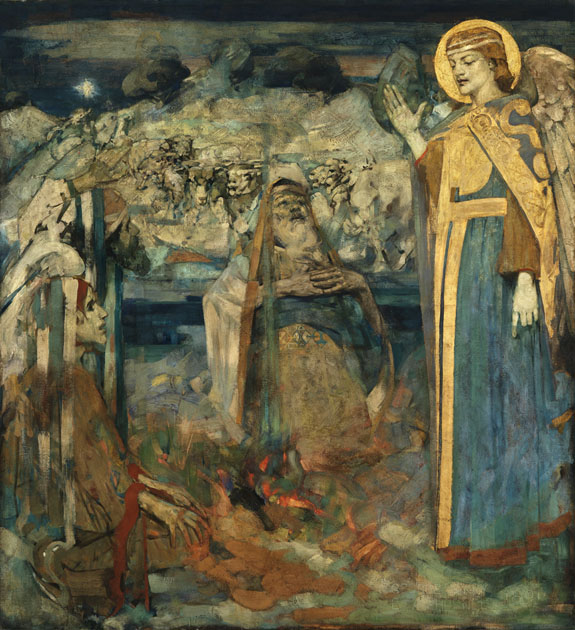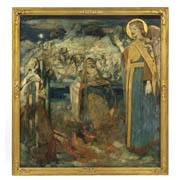Details
- Object type
painting
- Title
The Star in the East
- Artist/Maker
George Henry artist
Edward Atkinson Hornel artist
- Culture/School
Glasgow Boys
- Place Associated
Scotland, Dumfries and Galloway, Kirkcudbright (place made)
- Date
1891
- Materials
oil on canvas
- Dimensions
framed: 2154 x 2002 x 70 mm;unframed: 1984 mm x 1829 mm
- Description
-
This painting is one of two collaborative artworks that Glasgow Boys George Henry and E. A. Hornel made together in 1890-91, the other being The Druids: Bringing in the Mistletoe (1890). Henry and Hornel had met by 1885 when Henry and James Guthrie visited Hornel in Kirkcudbright in Dumfries & Galloway. They developed a close friendship in the late 1880s that led to a period of creative experimentation and conceptual maturation, strengthened by working together on large-scale decorative murals for the 1888 International Exhibition in Glasgow. Moving away from Naturalism and everyday subject matter to something more mystical and enigmatic, their paintings becoming increasingly symbolic and ornamental, with little traditional perspective, brushwork merging figures and settings, creating a patterned surface. This is evident in the decorative overlap of shepherds, fire, sheep and hillside in The Star in the East.
In both The Druids and The Star in the East Henry and Hornel used gold leaf over incised gesso to enhance the paintings’ decorativeness and sacred mysticism, showing an awareness of early Italian art. The Belgian poet and critic Emile Verhaeren, reviewing The Druids in 1891, regarded the painting as directly related to the works of Italian Renaissance masters Carlo Crivelli, Lorenzo da San Severino and Vincenzo Foppa on display at the National Gallery in London. The works also point to the influence of the Pre-Raphaelites on developments within Scottish art. Examples of the paintings of Edward Burne-Jones, Dante Gabriel Rossetti and Arthur Hughes were to be seen at the 1888 International Exhibition in Glasgow, as well as at the annual exhibitions of the Royal Scottish Academy and Glasgow Institute of the Fine Arts. In The Star in the East the gilding adds to the sense of awe and wonder at this angelic being who says, ‘Do not be afraid. I bring you good news that will cause great joy for all the people.’
Interestingly there appears to be a prehistoric chambered cairn on the hillside in the background, which may have been inspired by the landscape of Hornel’s native Galloway and perhaps alludes to a child born to fulfil ancient prophecy and yet a child born to die. Hornel in particular was fascinated by Scottish archaeology and his library held many books and pamphlets on the subject, including the Proceedings of the Society of Antiquaries of Scotland. The angel’s robes also appear to be decorated with Celtic and Pictish designs as were the ceremonial robes of the priests and celebrants in The Druids. Both paintings represent the first flowering of a Celtic Revival in Scotland. Glasgow art dealer Alexander Reid acted as agent for the sale of The Star in the East but it did not find a buyer and Henry referred to it as the ‘white elephant’ in his letters. He was ill during the production of this painting which may be partly why the painting lacks the energy and decorative originality of The Druids.
And the peace and goodwill between the two artists was not to last. In 1893-94 Henry and Hornel were to spend 18 months together in Japan, seeking fresh inspiration from Japanese art and culture, funded by Reid. However, this trip resulted in a fracture in their relationship after Henry’s paintings incurred damage on the return voyage and he was unable to exhibit them alongside Hornel’s back in Glasgow. It must have been galling when Hornel’s works brought critical acclaim. Tensions had been mounting even before their trip. When Hornel fell out with artist W. G. MacGeorge, Henry wrote: ‘After all it is impossible for two fellows to work together, at least for any lengthened period: this was growing in on me last year and all this spring […] the novelty wears off and one finds a thousand and one little things, that to produce anything or get a more
- Credit Line/Donor
Purchased, 1960
- ID Number
3137
- Location
Kelvingrove Scottish Art


